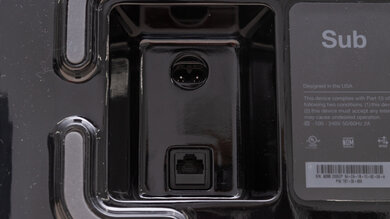Our Verdict
Decent for mixed usage. The Yamaha YAS-408 has a great audio reproduction that is suitable for most music genres and dialogue content like podcasts and audiobooks. However, it has sub-par performance with surround channels and doesn’t support height channels, resulting in a less immersive listening experience with movies. Unfortunately, its soundstage isn’t that wide, and the bar will downmix surround content down to stereo.
- Neutral and accurate audio reproduction.
- Well-built design.
- Great for voice-oriented content.
- Lacks sub-bass.
- Horrible virtual 3D surround sound mode.
Great for dialogue. You can use the Yamaha Bar 400 to listen to podcasts, audiobooks, or other similar content types. The sound profile is very neutral and the overall reproduction of voices is accurate. It can also get pretty loud and you can also use the Dialogue Enhancement feature to get an even better listening experience. You’ll be able to stream content from your phone wirelessly, but unfortunately, it doesn’t have an auto-volume or night mode to normalize the sound of your different types of content.
Decent for music. The Yamaha MusicCast Bar 400's audio reproduction is accurate, but some people might feel it lacks a bit of bass, especially on bass-heavy content. While its soundstage isn’t very wide, it's well-focused and doesn’t sound too diffused. There’s not much compression at a moderate volume, but when pushed at the maximum volume, you might hear a bit of pumping and compression artifacts in the bass range, especially on bass-heavy genres. On the upside, you can easily adjust the subwoofer's level separately.
Okay for movies. The Yamaha MusicCast Bar 400 has good overall audio reproduction, but it doesn’t do well with surround channels. On top of that, the soundstage isn’t that wide and it doesn’t have height channels. All of this results in a less immersive listening experience. This 2.1 setup will downmix 5.1 content and won’t sound as real as other setups, but the virtual surround mode might help a bit. On the upside, you have a few features to customize your sound a bit to your liking, although you won’t have room correction.
Changelog
- Updated Dec 10, 2021: Added third-party voice assistant compatibility.
- Updated Mar 30, 2021: Converted to Test Bench 1.0.
- Updated Sep 27, 2019: Review published.
Check Price
Popular Soundbar Comparisons
The Yamaha YAS-408 is a decent soundbar with a great audio reproduction, especially with dialogue and stereo content. It's well-built and comes with a decent subwoofer, but some may feel it lacks sub-bass. It also has two surround modes, but we suggest never using the 3D surround as its quality is bad and it doesn't offer an immersive experience. See our recommendations for the best soundbars, the best soundbars with subwoofer, and the best Dolby Atmos soundbars.
The Sonos Beam (Gen 2) is better than the Yamaha YAS-408. The Sonos is a better built 5.0 setup that supports Dolby Atmos content. It has better soundstage, center, and surround performances, too. However, the 2.1 Yamaha has a dedicated subwoofer and can reproduce a more extended low-bass. It also gets louder with a bit less compression at max volume.
The standalone Sonos Arc is a better soundbar than the Yamaha YAS-408. The Sonos is better built, and unlike the Yamaha, it supports Dolby Atmos content and has built-in voice assistant support. It offers better soundstage, center, and surround performances and even comes with a room correction feature. However, the Yamaha reproduces a more extended low-bass, supports more wireless playback options, and has a Full HDMI In port.
The JBL Bar 9.1 is better than the Yamaha YAS-408. The JBL is a 5.1.4 setup that's better-built and comes with dedicated satellites. It has better soundstage, center, and surround performances, and it comes with more sound enhancement features. Unlike the Yamaha, it also supports Dolby Atmos content.
Depending on your listening habits, you may prefer either the Yamaha YAS-408 or the JBL Bar 5.1 Surround. The Yamaha is a 2.1 setup with a better soundstage. It also gets louder with less compression at max volume. However, the 5.1 JBL is better built, with better surround and center performances. It comes with room correction and Chromecast built-in support, unlike the Yamaha.
Test Results




























